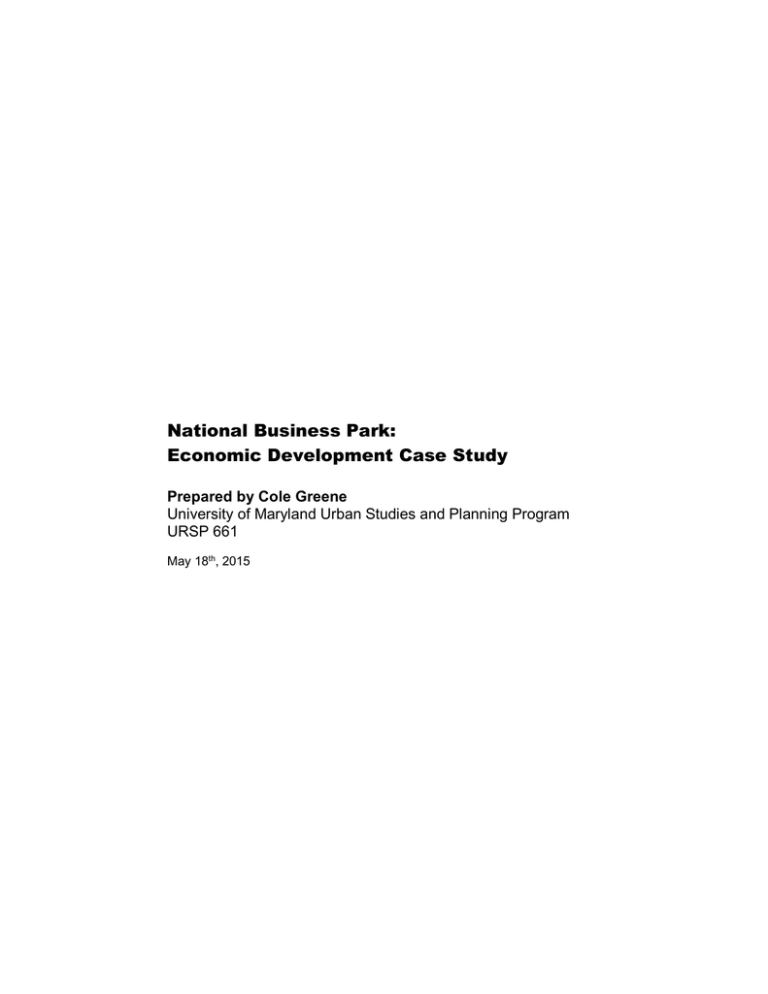National Business Park: Economic Development Case Study
advertisement

National Business Park: Economic Development Case Study Prepared by Cole Greene University of Maryland Urban Studies and Planning Program URSP 661 May 18th, 2015 National Business Park: Economic Development Case Study Background and History As the United States continues to grapple with the difficult transition from an economy predicated on manufacturing toward a knowledge-based economy, changes can be noticed on both a macro and micro scale. While efforts are being made at the federal and state policy level to “reshore” manufacturing jobs, the growth potential is seen in “research and development” and other knowledge-intensive sectors1. These trends are also being noticed at a planning level as jurisdictions look to position themselves to become the next Silicon Valley. There are a multitude of factors that will ultimately determine where the next high tech cluster will develop, many of them impossible to predict. In order to gain a better understand how the future may unfold, it is important to first understand how the present came to be. This paper will look to further the general understanding of the modern knowledge-based economy through a case study of a research and development style industrial park in Anne Arundel County, Maryland. Figure 1. National Business Park Regional Context Map National Business Park is a 285 acre site in Anne Arundel County, Maryland located just northwest of Fort George G. Meade (Fort Meade), 14 miles from Baltimore and 21 miles from Washington, D.C.. National Business Park is, for all intents and purposes, a byproduct of Fort Meade and so a discussion of the history of Fort Meade is required to understand the history of National Business Park. Fort Meade (then Camp Admiral) opened in 1917 as a training camp, served as an air defense base during the Cold War. In 1988, the U.S. military created the Base Realignment and Closure (BRAC) Commission, which is a congressionally authorized process the Department of Defense (DoD) has used to reorganize its base structure to 1 National Business Park: Economic Development Case Study more efficiently and effectively2. In 2005, the BRAC Commission slated Fort Meade for realignment, which resulted in an inflow of DoD agencies and employment. Fort Meade is now home to a number of defense-related agencies including the National Security Agency (NSA) and Defense Information Systems Agency (DISA). Figure 2. National Business Park Local Context Map The land that National Business Park is located on was purchased in 1986 by Corporate Office Properties Trust (COPT) and began development as an office park in 1988. Adjacent land was purchased in 2006 (likely in response to BRAC announcements). The site is zoned “W-1 Industrial Park” by Anne Arundel County3. The office park currently has 28 buildings and over 3.2 million square feet of office space. Location Quotient and Shift Share Calculating a location quotient (LQ) is a way to measure a particular industry’s concentration in a particular area compared to a larger geographic area. A shift-share analysis is a tool used to examine whether employment growth (or decline) is the result of location advantages, industry trends or economics of the broader region. National Business Park will be evaluated using both methods. The formula for computing shift share can be represented as follows: where: 2 National Business Park: Economic Development Case Study ei = local employment in industry i e = total local employment Ei = larger geographic area employment in industry i E = total larger geographic area employment The location quotients for each industry in both 2008 and 2012 are shown in Table 1 below. Table 1. National Business Park Location Quotients1 Industry Manufacturing Wholesale trade Finance and insurance Real estate and rental and leasing 2008 Employment 2012 Employment 2008 LQ 2012 LQ 1 85 0 31 279 160 4 55 0.00 0.54 0.00 0.29 0.91 0.64 0.01 0.30 3784 3.03 2.78 1 23 13 73 90 4482 1.45 0.07 0.20 0.58 0.00 0.01 0.03 0.05 0.53 0.20 Professional and technical services 2227 Management of companies and enterprises 100 Administrative and waste services 35 Health care and social assistance 29 Accommodation and food services 46 Public administration 0 Total 2554 1 State of Maryland used as larger geographic area Sources: Maryland Quarterly Census of Employment and Wages, Bureau of Labor and Statistics The “professional and technical services” industry is the predominant industry within National Business Park, with 87% of the total employment in 2008 and 84% of the total employment in 2012. It is important to note that employment data at as small a scale as a single business park may be misleading. Industry codes are self reported and do not necessarily depict the exact nature of economic activities occurring. That being said, National Business Park clearly has a strong presence in the knowledge-based economy. A shift share analysis over the same period (2008-2012) will determine, for each industry, whether growth occurred due to regional trends, industry trends, or locational advantages. Table 2 below presents the results of the shift-share analysis. While Maryland’s total employment declined over the time period, the “professional scientific and technical services” industry showed growth in the State. This growth, however, only accounts for 102 new “professional scientific and technical” jobs within National Business Park, while locational advantages accounted for 1,478 new jobs. The locational advantages that National Business Park holds are undoubtedly associated with its proximity to Fort Meade. Maryland Quarterly Census of Employment and Wages (QCEW) data indicates that tenants of the business park are largely private defense contractors though it is likely that there are government tenants mixed in as well. 3 National Business Park: Economic Development Case Study Table 1. Shift Share Analysis of National Business Park Change from industry's growth in MD Change attributed to district Total Change 2008 District Employment 2012 District Employment Percent Change Change from MD total Economy 1 85 279 160 27800% 88% 0 -1 0 -9 278 85 278 75 Finance and insurance Real estate and rental and leasing Professional and technical services Management of companies and enterprises Administrative and waste services Health care and social assistance Accommodation and food services Public administration 0 31 2227 4 55 3784 N/A 77% 70% 0 0 -23 0 -1 102 N/A 25 1478 4 24 1557 100 35 29 46 0 1 23 13 73 90 -99% -34% -55% 59% N/A -1 0 0 0 0 16 0 2 -1 0 -114 -12 -18 28 N/A -99 -12 -16 27 90 Total 2554 4482 75% -26 109 1752 1928 Industry Manufacturing Wholesale trade Sources: Maryland Quarterly Census of Employment and Wages, Bureau of Labor and Statistics Successes and Shortcomings National Business Park is an unequivocal success in terms of providing employment and employment growth. However, this success is likely a by-product of government-induced demand, and thus not easily replicable without a particular set of circumstances. There are several lessons that can be learned. The first lesson is that government contracts can spur private sector industry clust ering. While there is only one Fort Meade, other jurisdictions can look to use the general strategy of consolidating government agencies (as was the case in BRAC) to induce the creation of private sector clusters of firms with government contracts. The second lesson is that a properly educated work force is necessarily a prerequisite for the formation of any knowledge-based industry cluster. According to Education Week, Maryland has the third best public education system of any state in the U.S. 4 National Business Park: Economic Development Case Study The cyber-security industry is seen as a major area for potential growth within both the national and regional economies. In 2013, President Barack Obama signed Executive Order 13636: “Improving Critical Infrastructure Cybersecurity” 5. The role of the federal government in the cybersecurity industry is and will remain instrumental, giving the broader region around Fort Meade potential to capitalize on an industry primed for future growth. But while the seclusion and secrecy associated with the National Business Park may be beneficial to its role with the DoD, but it hampers the potential for knowledge spillover effects throughout the region. Diffusion of technology and knowledge is critical to forming competitive clusters in knowledge-intensive industries such as cyber-security. If the region is committed to facilitating the growth of this kind of cluster, there must be public sector involvement in diffusing knowledge and technology where possible. This can be accomplished through public and private learning institutions. More on this will be discussed in the following section. Recommendations for the Future 1. Government and Educational institutions should continue to coordinate with both public and private leaders in cyber-security. The region currently boasts strong institutional infrastructure in the cyber-security industry with Federal anchors such as the NSA, the National Institute of Technology and Standards (NIST), DISA, the Intelligence Advanced Research Projects Activity (IARPA) as well as the National Cybersecurity Center of Excellence (NCCOE) in Rockville, MD. The area also boasts cybersecurity research leaders such as the University of Maryland Baltimore County (Cryptology, Network Security, Intrusion Detection, Quantum Cryptography, Electronic Commerce, Secure Software Agents, Multicast Security, Voting Systems, Health Care Information Systems), Johns Hopkins (Networking, Wireless, Systems Evaluation, Medical Privacy and Electronic Voting, Emergency Health Preparedness, Bio-terrorism), University of Maryland College Park (Network Security, Mobile and Sensor Networks, Hybrid Communication Networks, MEMS Sensor Design and Fabrication, Nanotechnology, System Engineering Methodologies, Supply Chain Management, Economics of Information Security) and Morgan State University (Bioinformatics).6 2. Local jurisdictions should seek to meet the security and facility needs of private firms with appropriate zoning, infrastructure improvements. Firms specializing in cybersecurity and other data-intensive industries will undoubtedly require fast and reliable internet access as well as high security buildings. Local and regional planning organizations should look to collaborate with leading cyber-security firms and real estate developers such as COPT to determine how much space and what types of infrastructure improvements the industry will need moving forward. Connectivity is the key to knowledge spillover and agglomeration economies. While technology improvements have allowed for more telecommuting and non face-to-face meetings, physical accessibility is still the key to knowledge spillover. Transportation infrastructure will be a key component of this as well as the facilitation of social network expansion. 5 National Business Park: Economic Development Case Study 3. Economic development organizations should encourage commercialization of cybersecurity technologies originally developed for the public sector. Diversifying the customer market will ensure the continued growth of the industry locally. The cybersecurity industry in this region is currently dominated by private firms with DoD contracts or connections to DoD contracts. Maryland’s top IT defense contractors include Boeing, Booz Allen Hamilton, CACI International, Computer Sciences Corporation, General Dynamics Corporation, Honeywell International, IBM, L3 Communications, Lockheed Martin Corporation, MITRE, Northrop Grumman Corporation and SAIC6. Economic development organizations can act as a liaison between private companies and local entrepreneurs to facilitate innovation. The effectiveness of incubator style projects such as the Chesapeake Innovation Center (CIC) in Anne Arundel County should be explored. References 1 http://www.oecd.org/sti/sci-tech/1913021.pdf http://www.defense.gov/brac/ 3 http://www.amlegal.com/nxt/gateway.dll/Maryland/annearundelco_md/article18zoning?f =templates$fn=default.htm$3.0$vid=amlegal:annearundelco_md 4 http://www.edweek.org/ew/qc/2015/2015-state-report-cards-map.html?intc=EW-QC15LFTNAV 5 https://www.whitehouse.gov/issues/foreign-policy/cybersecurity/eo-13636 6 http://business.maryland.gov/Documents/ResearchDocument/CybermarylandReport.pdf 2 6





